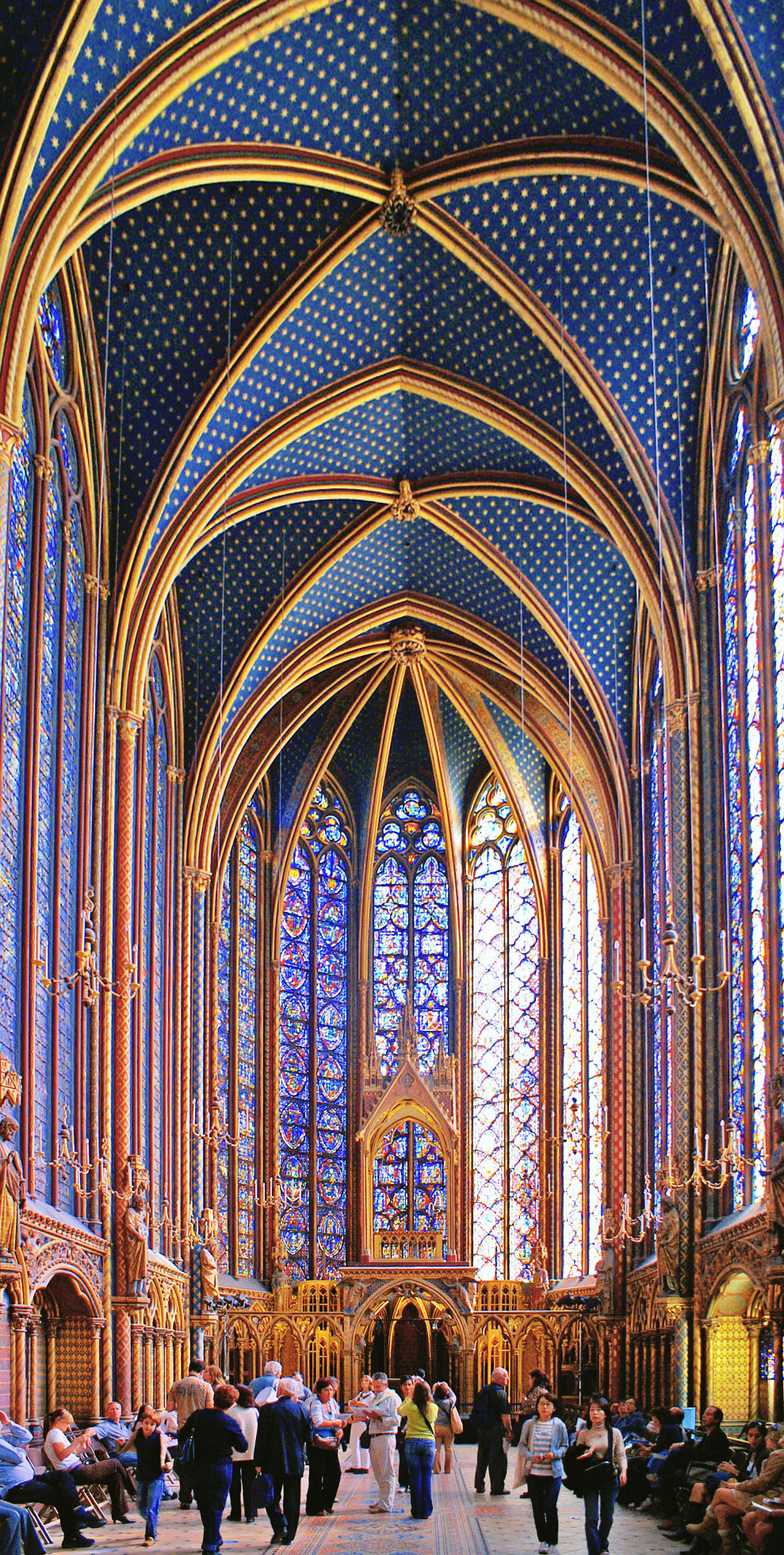Cast-iron gothic tracery supports a bridge by Calvert Vaux, Central Park, New York City

The upper chapel of the Sainte Chapelle, restored by Eugène Viollet-le-Duc in the 19th century -- the colors are just delicious.

Victoria Tower at the Palace of Westminster, London: Gothic details provided by A.W.N. Pugin

Sir Christopher Wren's Tom Tower, at Christ Church, Oxford. The frosty blues in this image are so moody and evocative. Love it.

Apparently, all this mid-18th-century Gothic Revival goodness started in England. Medieval-looking stuff was all the rage, "and perhaps more Gothic architecture was built in nineteenth and twentieth centuries than had originally ever been built," which amuses me immensely. Will nostalgia ever become old hat?
"Gothic architecture is generally considered to have begun at the Abbey of Saint-Denis, Paris, in 1140 and ended with a last great flourish at Henry VII[']s Chapel at Westminster in the early 16th century."
It didn't really die, though, because people who wanted churchy things and university things kept demanding the Gothic look. It's admittedly a pretty imposing look, suitable for inspiring fear of God and so forth.
Restoration became a big thing, and this included a surge in nationalism; every country claimed that it had invented the Gothic look first.
"A few Britons, and soon some Germans, began to appreciate the picturesque character of ruins — 'picturesque' becoming a new aesthetic quality".
In other words, why restore things when you can just build some fresh ruins which look all sorts of moody and evocative? Those wacky Romantics!
"In Contrasts (1836), Pugin . . . [claimed] that Gothic architecture was the product of a purer society. . . . Pugin believed Gothic was true Christian architecture, and even claimed 'The pointed arch was produced by the Catholic faith'. Pugin's most famous building is The Houses of Parliament in London, which he designed in two campaigns, 1836–1837 and again in 1844 and 1852".
Is it just me, or does this sound suspiciously Hitlerian, as in 'Gothic architecture is Aryan architecture'? Boo hiss, Augustus Welby Northmore Pugin! Just as an aside, the guy died when he was only forty, possibly from mercury poisoning (see http://en.wikipedia.org/wiki/Augustus_Pugin).
Eugène Viollet-le-Duc, unlike many popular Gothic-lovin' folks, felt that Gothic-y stuff should be restored with modern-day materials, including cast iron, rather than trying to imitate what had already been done. This inspired new designers to create Gothic-y-looking structures which could never have been made just out of stone, and hinted at the beginnings of my all-time-favorite art movement, Art Nouveau.
"Carpenter gothic houses and small churches became common in North America in the late nineteenth century. These structures adapted Gothic elements such as pointed arches, steep gables, and towers to traditional American light-frame construction. . . . But in most cases, Carpenter Gothic buildings were relatively unadorned, retaining only the basic elements of pointed-arch windows and steep gables. Arguably, the most famous example of carpenter gothic is not even a real building. It appears in the background of the painting American Gothic by Grant Wood."
I don't have a smart-alecky comment to that one, I just think it's cool. And Grant Wood was simply brilliant. Such liquid colors! Such eye-popping clarity! Such vibrant compositions! Ooh, I just love him. In fact, look at this:

"The Midnight Ride of Paul Revere," by Grant Wood
This image doesn't do the original painting any justice; go to the Metropolitan Museum of Art in New York and see this sometime. It looks eerie, and almost like it's underwater. I first saw this painting in person several years ago, and it haunts me still. Now that's what I call art.
"At the turn of the 20th Century, technological developments such as the light bulb, the elevator, and steel framing caused many to see architecture that used load-bearing masonry as obsolete. Steel framing supplanted the non-ornamental functions of rib vaults and flying buttresses. Some architects used Neo-Gothic tracery as applied ornament to an iron skeleton underneath".
In other words, we still like the look, but wouldn't ever dream of using such archaic building techniques, so we slap the look onto inherently modern structures. Personally, I'm cool with that -- Gothic (and Gothic Revival) buildings from the inside tend to be dark, dreary, and rather pinched, with teensy windows and drafty everything.
Still, I do kinda miss flying buttresses.
No comments:
Post a Comment